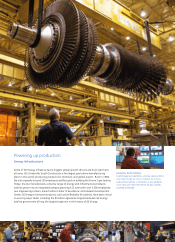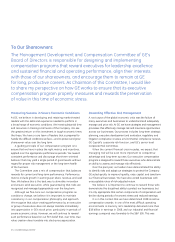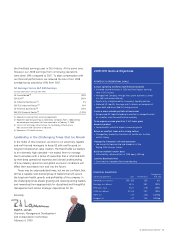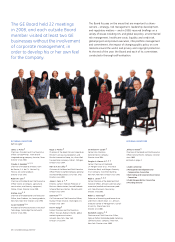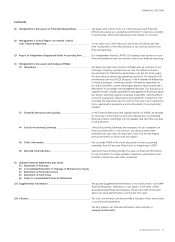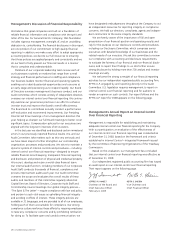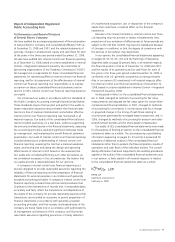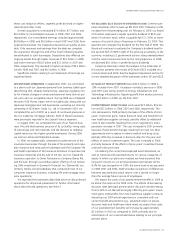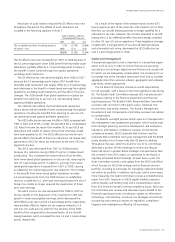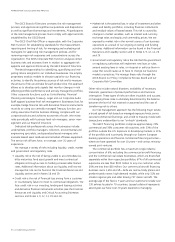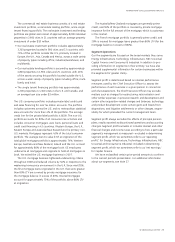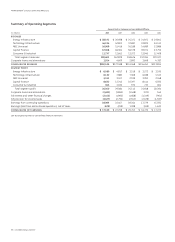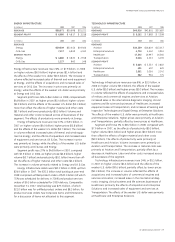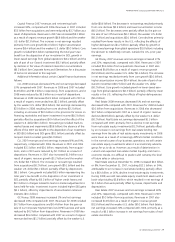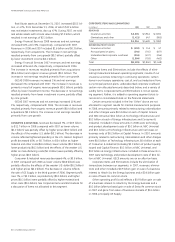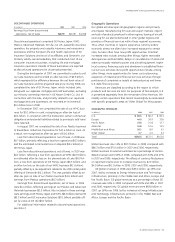GE 2008 Annual Report Download - page 23
Download and view the complete annual report
Please find page 23 of the 2008 GE annual report below. You can navigate through the pages in the report by either clicking on the pages listed below, or by using the keyword search tool below to find specific information within the annual report.management’s discussion and analsis
ge 2008 annual report 21
these cost reduction efforts, segment profit declined on higher
material and other costs.
Overall, acquisitions contributed $7.4 billion, $7.7 billion and
$3.9 billion to consolidated revenues in 2008, 2007 and 2006,
respectively. Our consolidated earnings included approximately
$0.8 billion in 2008, and $0.5 billion in both 2007 and 2006, from
acquired businesses. We integrate acquisitions as quickly as pos-
sible. Only revenues and earnings from the date we complete
the acquisition through the end of the fourth following quarter
are attributed to such businesses. Dispositions also affected our
ongoing results through higher revenues of $0.1 billion in 2008
and lower revenues of $3.6 billion and $1.3 billion in 2007 and
2006, respectively. This resulted in higher earnings of $0.4 billion
in both 2008 and 2007, and $0.1 billion in 2006.
Significant matters relating to our Statement of Earnings are
explained below.
DISCONTINUED OPERATIONS. In September 2007, we committed
to a plan to sell our Japanese personal loan business (Lake) upon
determining that, despite restructuring, Japanese regulatory lim-
its for interest charges on unsecured personal loans did not per-
mit us to earn an acceptable return. During 2008, we completed
the sale of GE Money Japan, which included Lake, along with our
Japanese mortgage and card businesses, excluding our minority
ownership in GE Nissen Credit Co., Ltd. In December 2007, we
completed the exit of WMC as a result of continued pressures in
the U.S. subprime mortgage industry. Both of these businesses
were previously reported in the Capital Finance segment.
In August 2007, we completed the sale of our Plastics busi-
ness. We sold this business because of its cyclicality, rising costs
of natural gas and raw materials, and the decision to redeploy
capital resources into higher-growth businesses. During 2006,
we sold our Advanced Materials business.
In 2006, we substantially completed our planned exit of the
insurance businesses through the sale of the property and casu-
alty insurance and reinsurance businesses and the European life
and health operations of GE Insurance Solutions Corporation (GE
Insurance Solutions) and the sale of GE Life, our U.K.-based life
insurance operation, to Swiss Reinsurance Company (Swiss Re),
and the sale, through a secondary public offering, of our remain-
ing 18% investment in Genworth Financial, Inc. (Genworth), our
formerly wholly-owned subsidiary that conducted most of our
consumer insurance business, including life and mortgage insur-
ance operations.
We reported the businesses described above as discontinued
operations for all periods presented. For further information
about discontinued operations, see Note 2.
WE DECLARED $12.6 BILLION IN DIVIDENDS IN 2008. Common per-
share dividends of $1.24 were up 8% from 2007, following a 12%
increase from the preceding year. On February 6, 2009, our Board
of Directors approved a regular quarterly dividend of $0.31 per
share of common stock, which is payable April 27, 2009, to share-
owners of record at close of business on February 23, 2009. This
payment will complete the dividend for the first half of 2009. The
Board will continue to evaluate the Company’s dividend level for
the second half of 2009 in light of the growing uncertainty in the
economy, including U.S. government actions, rising unemployment
and the recent announcements by the rating agencies. In 2008,
we declared $0.1 billion in preferred stock dividends.
Except as otherwise noted, the analysis in the remainder of
this section presents the results of GE (with GECS included on a
one-line basis) and GECS. See the Segment Operations section for
a more detailed discussion of the businesses within GE and GECS.
GE SALES OF PRODUCT SERVICES were $35.5 billion in 2008, a
10% increase from 2007. Increases in product services in 2008
and 2007 were led by growth at Energy Infrastructure and
Technology Infrastructure. Operating profit from product services
was $9.3 billion in 2008, up 3% from 2007.
POSTRETIREMENT BENEFIT PLANS costs were $2.2 billion, $2.6 bil-
lion and $2.3 billion in 2008, 2007 and 2006, respectively. The
cost decreased in 2008 primarily because of the effects of prior
years’ investment gains, higher discount rates and benefits from
new healthcare supplier contracts, partially offset by additional
costs of plan benefits resulting from union negotiations and a
pensioner increase in 2007. The cost increased in 2007 primarily
because of plan benefit changes resulting from new U.S. labor
agreements and increases in retiree medical and drug costs,
partially offset by increases in discount rates for the year and
effects of recent investment gains. The cost increased in 2006
primarily because of the effects of prior-years’ investment losses
and lower discount rates.
Considering the current and expected asset allocations, as
well as historical and expected returns on various categories of
assets in which our plans are invested, we have assumed that
long-term returns on our principal pension plan assets will be
8.5% for cost recognition in 2009, the same level as we assumed
in 2008, 2007 and 2006. GAAP provides recognition of differences
between assumed and actual returns over a period no longer
than the average future service of employees.
We expect the costs of our postretirement benefits in 2009 to
be about the same as the 2008 costs. The effects of decreasing
discount rates (principal pension plans’ discount rate decreasing
from 6.34% to 6.11%) will be largely offset by prior-years’ invest-
ment gains and benefits from new healthcare supplier contracts.
Assuming our 2009 actual experience is consistent with our
current benefit assumptions (e.g., expected return on assets,
discount rates and healthcare trend rates), we expect that costs
of our postretirement benefits will increase by approximately
$1.0 billion in 2010 as compared to 2009, primarily due to
amortization of our unamortized losses relating to our principal
pension plans.


